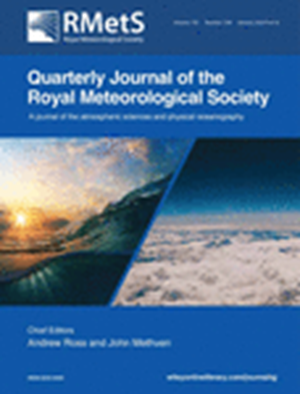The impact of the Madden–Julian oscillation on extreme winter weather over the contiguous United States
IF 2.9
3区 地球科学
Q2 METEOROLOGY & ATMOSPHERIC SCIENCES
引用次数: 0
Abstract
Despite its substantial impacts on human society, winter weather is difficult to predict on subseasonal‐to‐seasonal (S2S) timescales. To improve its predictability at longer timescales, this study examines whether the Madden–Julian Oscillation (MJO) has a significant impact on the frequency of extreme winter weather (i.e., heavy accumulations of snow, ice pellets, and freezing rain) over the contiguous United States. We find an increased frequency of extreme winter weather in the Ohio Valley and Mid‐Atlantic regions when MJO enhanced convection is over Africa and the western Indian Ocean, due to imposed lower 850‐hPa temperatures associated with MJO teleconnections. More frequent subfreezing temperatures lead to an increased likelihood of frozen precipitation compared with liquid, increasing the frequency of extreme winter weather. The MJO also increases the frequency of winter weather in the Central Great Plains region of the United States when MJO enhanced convection is over the eastern Indian Ocean and the Maritime Continent. Rather than through effects on temperature, the likely mechanism of increased winter weather over this region is enhanced synoptic forcing that increases overall precipitation. These effects can be seen up to 15 days in advance, suggesting the utility of using the MJO in S2S forecasting of extreme winter weather.马登-朱利安振荡对美国毗连地区冬季极端天气的影响
尽管冬季天气对人类社会有重大影响,但在亚季节到季节(S2S)时间尺度上却很难预测。为了提高其在更长时间尺度上的可预测性,本研究考察了麦登-朱利安涛动(MJO)是否对美国毗连地区冬季极端天气(即大量积雪、冰粒和冻雨)的频率有重大影响。我们发现,当 MJO 在非洲和西印度洋上空增强对流时,俄亥俄河谷和大西洋中部地区出现极端冬季天气的频率会增加,原因是 MJO 远缘联系导致 850 hPa 温度降低。与液态降水相比,更频繁的低温导致冰冻降水的可能性增加,从而增加了冬季极端天气的频率。当 MJO 在印度洋东部和海洋大陆上空增强对流时,MJO 也会增加美国中部大平原地区冬季天气的频率。该地区冬季天气增加的可能机制不是通过对温度的影响,而是通过增强的合流强迫来增加总体降水量。这些影响可以提前 15 天看到,这表明利用 MJO 对极端冬季天气进行 S2S 预测是有用的。
本文章由计算机程序翻译,如有差异,请以英文原文为准。
求助全文
约1分钟内获得全文
求助全文
来源期刊
CiteScore
16.80
自引率
4.50%
发文量
163
审稿时长
3-8 weeks
期刊介绍:
The Quarterly Journal of the Royal Meteorological Society is a journal published by the Royal Meteorological Society. It aims to communicate and document new research in the atmospheric sciences and related fields. The journal is considered one of the leading publications in meteorology worldwide. It accepts articles, comprehensive review articles, and comments on published papers. It is published eight times a year, with additional special issues.
The Quarterly Journal has a wide readership of scientists in the atmospheric and related fields. It is indexed and abstracted in various databases, including Advanced Polymers Abstracts, Agricultural Engineering Abstracts, CAB Abstracts, CABDirect, COMPENDEX, CSA Civil Engineering Abstracts, Earthquake Engineering Abstracts, Engineered Materials Abstracts, Science Citation Index, SCOPUS, Web of Science, and more.

 求助内容:
求助内容: 应助结果提醒方式:
应助结果提醒方式:


